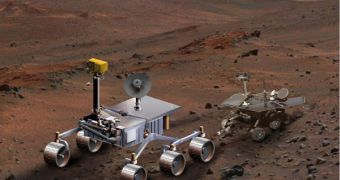The American space agency's plans for future missions on the Red Planet seem to be in serious trouble, as NASA is currently dealing with an increased criticism from people saying that the costs associated with exploring Mars are simply too great, as related to the benefits. In addition, our neighboring planet is currently starting to lose its top dog status to the moons of gas giants, which new evidence shows may be more able to sustain life. Also, engineers are yet unsure as to which mission will be next on the agenda, and this uncertainty only means that at least 2 to 3 years will pass before it's actually launched.
The Moon has also started getting a lot more attention lately, with new missions exploring its deepest recesses and its dark side as well. The Japanese and the Chinese have also expressed their interest in visiting Earth's natural satellite. NASA runs the risk of being left behind in this race, while it's focusing its efforts on Mars. Despite the fact that the Red Planet has recently revealed some places that may still support life, future missions are still necessary, in order to make sure that at least microbes still live there.
According to NASA's Ames Research Center Mars researcher Chris McKay, there are currently a number of factors that have prompted a change of attitude towards our neighbor at the space agency. In the April edition of the Mars Society newsletter's The Mars Quarterly, he argues that, “The NASA Mars program is at a turning point,” on account of three factors. First of all, the next planned mission, the MSL, has run costs up to $2.2 billion, and has therefore been delayed to 2011.
In addition, as more and more complex instruments are needed on the Red Planet, the costs for future missions rise to such high sums, that they enter in the cost range of crucial NASA missions to the solar systems. In other words, it may necessitate more money to send robots on Mars than to send probes to Pluto and beyond, despite the serious differences in distances, planning and construction that are necessary.
Furthermore, the third reason is that astronomers believe missions to Mars have less chances of finding life than they would on Saturn's moon Titan and on Enceladus. The latter is spilling organic materials into its atmosphere, and the possibility of at least bacteria living in that environment is drastically higher than on Mars. On the Red Planet, life may exist, but most researchers agree that it may be buried so deep, that robots may be unable to dig it up from under miles of soil.
“It's fair to say that the Mars program is in disarray. NASA is still working to sort out the Mars Science Laboratory problems and from where the money will come to pay for the overruns,” University of Colorado in Boulder (UCB) Mars researcher and astrobiologist Bruce Jakovsky adds.
“A vigorous program of robotic exploration is needed to determine if Mars is a world in which humans can live and work and to prepare for human exploration. Orbiters, rovers, drills, and sample return missions are all needed to prepare for human exploration. For the Mars Program to remain viable, it needs to become part of the Exploration Program (...) it needs to focus on paving the way for human exploration. And this means sample return,” McKay explains.

 14 DAY TRIAL //
14 DAY TRIAL //